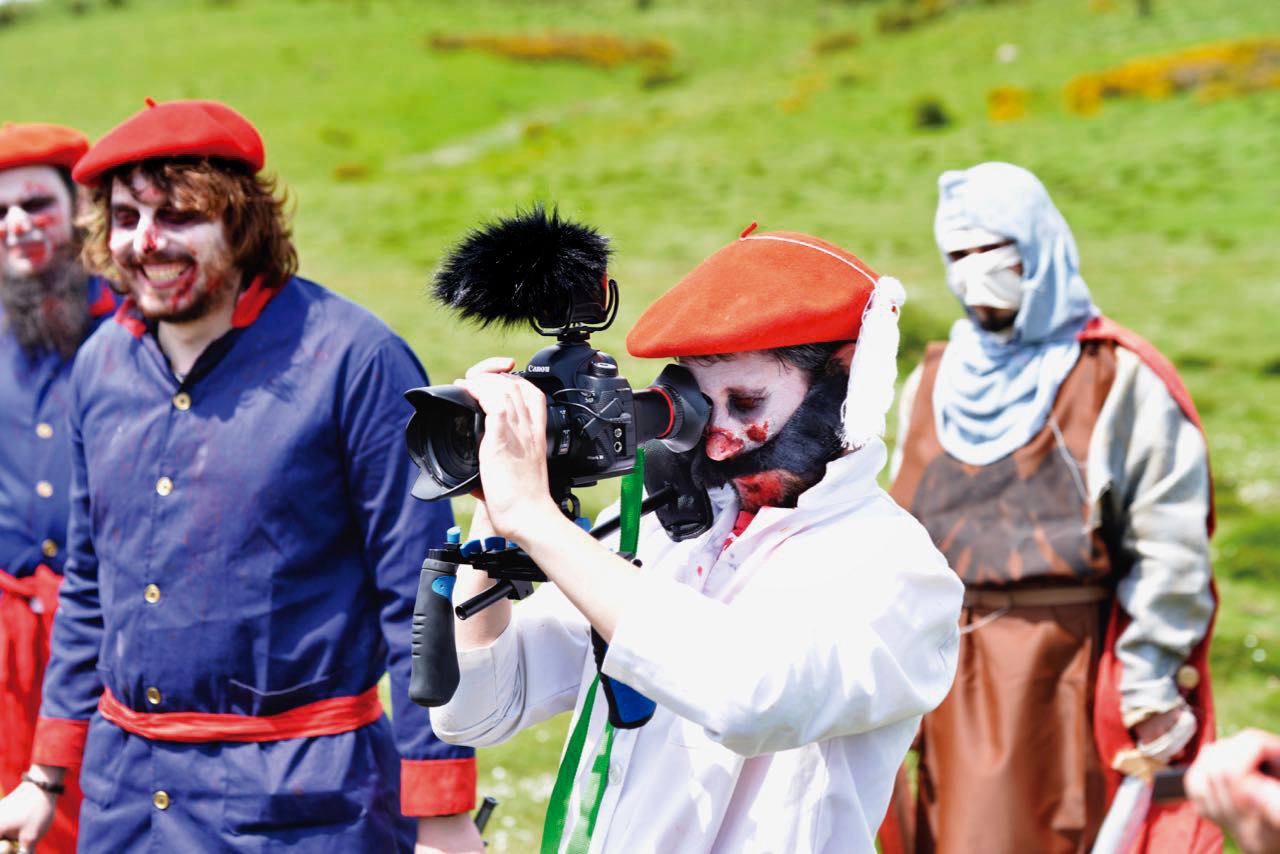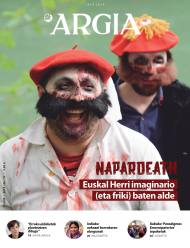"Myths interest us more than reality"
- The two Carlist scientists first resurrected Zumalacárregui (Ataun of the dead, 2012). Later, they defeated the Vampiric Basque Party, led by the lehendakari Agirre (Joxean´s Hil Eben, 2014). Now, Zumalacárregui has great wishes: he wants to proclaim himself to be king of all the Basques, and for that he has left Pamplona. But in this case, the road will become more complex than expected, because the Abertzale left has resurrected the mummy of Sancho the Fort, restoring the Navarre kingdom to recover the throne: With the premiere of Napardeath, the most entertaining project of the Basque film in the last decade has come to the top.

This leap from conception to the execution of the stones has conditioned, more than expected, the lives of Beñat Iturrioz, Jaione Irazu and Oskarbi Sein. In the end, for nine years, Katihotsak along with the other Logia colleagues, have spent a lot of hours writing scripts, preparing recordings, making costumes, attacking people, and, once the films are completed, projecting through the villages in theaters, printing merchandising t-shirts, selling, offering interviews. In the trilogy Ataun of the dead have risen Basque historical characters and brought wars between zombies to the screen. We have been received at the Iturola de Hernani, two of them in a space that have recently started to work – also in the audiovisual sector – and we have made a review of the experiences of these years, through the gaps that have left the trains of all classes – commuter, state, loaded.
Nine years ago, when you were cataloguing papers, you came up with the idea of forming a trilogy.
Beñat Iturrioz: Yes, Xabier Padin and I were working with Suhar archaeologists. We were in Ataun looking for bunches, following GPS locations, watching what state they were in, taking pictures ... And of course, when you spend eight hours around the bush, what do you do? Talk about nonsense. From that time is Dead Snow, a movie about Nazi zombies, but that genre we always liked: Night of the Living Dead, Town of the Living Dead… Padine said not enough movies were made about zombies. We've both studied history. Then we came up with the trilogy: in the first resurrected Zumalakarrangi, in the second the lehendakari Agirre against Zumalakarrangi and in the third Sancho the Fort. We have made a little sketch and that envy has brought us here. The road has been long.
Thinking, throwing -- it's really amazing.
Oskarbi Sein: Beñat has the ability to attract people. Anyone would not get it, but if BEÑAT starts with a project, it will surely come true. And the people around us followed us, because we're a little silly ...
Doctor B. Iturrioz: Among the penguins, there's always one that pulls down the cliff to make a hole in the iceberg and get to the sea. The first is usually suicidal and then followed by others.
Jaione Irazu: The most important thing for me is the first thing that follows him. Because it creates the environment that follows the one that pulls the stone.

That's what the famous video How to create a movement says: That the first follower is the most important to create the movement, more than the leader.
J. Consider: Creators and great ideas are mystified. Ideas are common to everyone, but an effort must be made to carry them out, the hours must be set. I give it a lot of courage, because I don't make much effort (laughing).
Oh! Six: We do not have audiovisual vocational training, but we have always been very fond of cinema. The seed was there. As echoed Ataun of the dead, we tried to make the second one better.
Doctor B. Iturrioz: The saddest thing is that the first one had an echo. This shows what is happening in the Basque culture. Drawing attention to this dejection means that there is nothing (laughs).
If to make a good film in Basque you have to make fifteen bad, you seem to be willing to make those fifteen bad.
Doctor B. Iturrioz: It's a combination of two theories. On the one hand, I don't know who said that 95 percent of cultural production is garbage. The remaining 5% is therefore a gem. If you have a field of a thousand hectares plagued by clover leaves, it's easier to find a four-leaf clover. On the other hand, you will find nothing like this in your house. The more it occurs, the more likely it is that nothing statistically good will occur. On the other hand, as all the energy in the universe is balanced, the negative energy we generate becomes another positive part. We are doing evil for good. If we do a lot of bad things, here someone in the vicinity will create a masterpiece. In other words, we're writing the top work of Harkaitz Cano, by reverse osmosis.
Don't put yourself in that humility now...
J. Consider: I value what we have done. Firstly, because it highlights the existing vacuum. And because it opens a door for those who want to do similar things. I enjoy as a spectator. The trilogy is located in the area where it is located, but before there was none in Euskera. Furthermore, everything is made in a natural way, without pretensions or ambitions.
Doctor B. Iturrioz: What we do is closer to popular theater or pastoral theater than to cinema. On these occasions people participate because they want, they are taught in the town square, people see it… They also have a lot of auzolan work: people come to help them in their free time, we give them food and drink. The film industry doesn't work that way.
Oh! Six: I remember we premiered the first film in a bar. We thought only we would see it. We didn't think we'd throw it anywhere else. But it opened -- not because the product was good, but because it filled a hole.
J. Consider: In Zuberoa they told us how they have to create all their cultural activity there, because they are out of all the cultural circuits. Singing, pastoral, theater… everything. The people create for the people. Here we are not as outside the circuit as they are, but in Basque there is nothing like these films. There was a vacuum, yes, but we didn't. That is a later reading.

The leap from Ataun of the dead to Joxean’s Hil Eben is evident, at least in terms of audiovisual quality.
Doctor B. Iturrioz: We have tried not to repeat the deficiencies observed in each film next time. With Ataun of the dead we went to the Zinegin Festival de Hazparne, where they play a game called zinequiz. One of the questions suggested that in our movie there was no Iparralde. Here's an explanation. The north was France in the imaginary of Zumalacárregui. There were Vascongadas and Navarre, and that's it. It was not very consistent to resurrect the guy and get him to talk about the seven territories. Instead, Napardeath starts in Vitoria-Gasteiz, it takes place in Navarra, it also goes through Baja Navarra and Zuberoa…
Oh! Six: In addition, unlike the first film, to make Napardeath we have met people from the seven territories, which helps to take these things into account.
Some historical characters have been changed by gender.
Doctor B. Iturrioz: Another thing they told us is that there wasn't enough women in it. Not as a historical character, not as a secondary character. It's not just been a challenge: on the one hand, because it's hard to conceive a lot of women's historical characters, and also, because you expect people to know them. We've been asking in feminist groups for some time what characters we could bring. Of course we didn't want to bring it to anybody. In Napardeath we have included Catherine of Erácoro, a conflictive figure, and when we have had occasion we have turned men into women, as Sancho the Fort is a woman. On the other hand, in film it is common for there to be more men on the technical team and more women on makeup. In our case, most of the work teams and those encouraged as extras have been men, and we have had to make a special effort to turn it around, although we have not quite achieved it.
If we don't imagine, we'll be imagined by others. That is what you have said.
Doctor B. Iturrioz: History is written by historians, or smugglers, but victors, in any case. Historians are often considered apolitical, but the one who writes history is making politics, is telling a story. We wanted to do the same exercise as Agosti Xaho. During the Carlist wars he was in Navarra and interviewed Zumalacárregui. There is Zumalakarrangi, abertzale, new Basque hope, etc. It has subsequently been shown that the conversation did not occur, which was invented by Xaho. We are more interested in myths than reality, and then feed our people with them. It doesn't matter if they're real or fake. What has actually happened in history, who knows? We do not rely on historical legitimacy to justify who we are. We are Euskaldunes because we want it.
Santi Leoné appears in the film, and he also says something like this in his attempt for an imaginary Basque Country: That the Basque Country is invented, and that it exists precisely because it has been invented.
Doctor B. Iturrioz: Yes, it is. Cinema has a special force for this, what is told in the movies is usually left in the imaginary of people. In the parable of Sancho the Fort written by Mark Legass is told how Sancho the Fort is both a mystified figure by the left abertzale and Spaniards. Supposedly, it was he who brought chains to Navarra. On the contrary, the Sancho the Fort portraying Legass is a guy who drank wine in Granada, who mocked the brothels, whom the people did not care about... And when they attacked Vitoria in Granada, it didn't matter much to lose it. Legass criticizes the mystification of history, and so do we. That's why the Sancho the Napardeath Fort is about a meter and a half, although it's actually over two meters.

You started trilogy with a hobby, but it's become something that takes you almost all the time off -- projections, interviews, etc. Does it get heavy?
Oh! Six: I, for example, didn't want to do this third party (laughing). As the dates approached, I thought: “Joxean’s Hil Eben was crazy, we’re going to get into beautiful mud.” But it had to be done. Then we had a great time and when you see the product, you feel proud. What you believe fills you. In addition, when you go down, another strip and you're enough.
Doctor B. Iturrioz: Yeah, starting with Napardeath, it made us a bit lazy. But we had a debt to ourselves, and also people were pushing us, “to see when you do the third one.”
J. Consider: Now we have the fresh process, but little by little, with the distance, maybe we change our perspective and forget how hard it has been.
Oh! Six: I believe that this time we will not be forgotten (laughing).
One last message?
Doctor B. Iturrioz: There will be no room.
Igandean aurkeztu dute Donostian Napardeath filma. 3.000 euroko aurrekontuarekin eta 150 laguntzaile baino gehiagoren ekarpenari esker osatu ahal izan duten filma.
Ikusi aurretik ere nire buruari egiten diodan galdera da: Joxean’s Hileben izango ote da 2014ko film sonatuena? Seguruenik ez, baina urteko produkzio dibertigarrienen rankingean merezita sartuko da.














